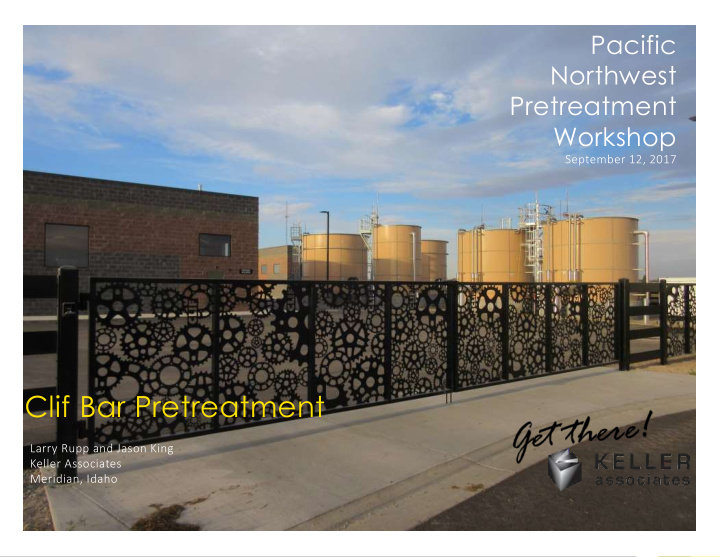



Pacific Northwest Pretreatment Workshop September 12, 2017 Clif Bar Pretreatment Larry Rupp and Jason King Keller Associates Meridian, Idaho 1 CITY OF LEWISTON WWTP 2020 IMPROVEMENTS
City of Twin Falls • Population: 48,260* • Major Industries • Glanbia Nutritionals (cheese) • AmeriPride (uniforms) • KapStone (cardboard) • Independent Meat Co. (pork) • Conagra (potato)** • Chobani (dairy)** • WWTP Capacity * City also treats the wastewater for the City of Kimberly (Pop. ~3,700) ** City owns and operates the pretreatment system at this industrial plant
Clif Bar Bakery/Pretreatment Facility • 1st Clif Bar-Owned Bakery • Pretreatment Facility constructed at same time as Bakery • City to own and operate Pretreatment Facility • Clif Bar potentially to own and operate in the future • Intermittent flows with variable concentrations, pH, and temperature • Expansion potential
Preliminary Design Considerations • Process understanding • Sampling • Design criteria • Preliminary discharge permit • Pretreatment options • Pretreatment selection
Process Understanding • Collaboration with Indianapolis Facility and Clif Bar • Historical sampling results • 10-day sampling procedure • Biochemical oxygen demand (BOD) • Total suspended solids (TSS), • Volatile suspended solids (VSS) • Chemical oxygen demand (COD) • Soluble COD • Total Kjeldahl nitrogen (TKN) • Ammonia (NH3-N) • Oil and grease (O&G) • Flow • Temperature
Historical Sampling Results
10-Day Sampling Results
Design Criteria • Influent Design Criteria • Average Day Flow – 14,800 gpd • Maximum Month Flow – 23,000 gpd • Maximum Day Flow – 38,800 gpd • Peak Hour Design Flow – 240 gpm • Design Influent BOD 5 Concentration – 4,160 mg/L • Design Influent TSS Concentration – 1,100 mg/L • Design Influent O&G Concentration – 90 mg/L • Other considerations • Influent temperature • Influent pH
Pretreatment Options Percentage 1. UASB 2. UAFF 3. UASB/ PMT Factors 4. SBR 5. TF/SC 6. AS 7. MBBR 8. RBC 9. MBR 10. Evaporator UAFF Sustainability 10% 4 4 4 3 3 3 3 3 3 1 Experience 5% 4 4 4 4 4 4 3 1 1 1 Operability 10% 3 3 3 4 3 3 3 2 1 2 Process Stability 10% 3 3 3 3 4 3 4 2 3 4 Ease of Startup 5% 3 3 3 4 4 4 4 3 3 4 Toxic Sensitivity 10% 2 2 2 4 4 4 4 3 3 4 Capital Cost 5% 2 2 2 3 3 3 3 3 2 1 Installation Cost 5% 3 3 3 3 3 3 3 3 2 5 O&M Cost 9% 3 3 3 3 3 3 3 3 1 1 Energy Cost 5% 3 3 3 3 3 3 3 3 2 1 Sewer Fee Cost 9% 4 4 4 4 4 4 3 2 5 5 Dewatering Cost 5% 4 4 4 3 3 3 3 3 3 2 Footprint 2% 4 4 4 3 3 2 3 1 4 5 Expandability 10% 4 4 4 3 3 2 3 1 2 5 Total 100% 3.26 3.26 3.26 3.39 3.39 3.17 3.25 2.37 2.47 2.94
Anaerobic (UASB) EQ TANK WASTE FLOW UASB SBR FROM CLIF BAR TO CITY FACILITY SCREEN Adv. • Effective for high-strength wastewater • Not affected by O&G Disadv. • Microorganisms do not respond quickly to loading changes • Requires heating • Requires gas collection, flaring
TF/SC TRICKLING EQ TANK SOLIDS WASTE FLOW FILTER CONTACT CLARIFIER FROM CLIF BAR TO CITY FACILITY SCREEN Adv. • Effective • Stable • Handles variable loads/ flows well Disadv. • Requires additional pumping and building space • Influenced by temperature and pH changes • High capital cost
SBR EQ TANK WASTE FLOW SBR FROM CLIF BAR TO CITY FACILITY SCREEN Adv. • More stable than anaerobic treatment options • Not sensitive to toxins • Cost effective • Smaller footprint Disadv. • Expensive expansion • Nutrient, pH, and O&G control important • Requires careful solids management • Not as stable as TF/SC or MBBR options
Selected Alternative - MBBR EQ TANK WASTE FLOW MBBR DAF FROM CLIF BAR TO CITY FACILITY SCREEN Adv. • Stable • Cost effective • Not sensitive to toxins • Effective at removing O&G Disadv. • Nutrient, pH, and O&G control important
Industrial Discharge Permit Development • EPA Requirements • WWTP Capacity • Collection System Capacity • Compliance point • Startup/Monitoring
Compliance Point • Influent vs effluent • Design concerns • Flow measurement with intermittent flow • Process concerns • Temperature and pH • Equalization tanks
Compliance • Influent manhole • 24-hour composite sampler for BOD 5 , TSS • FOG grab sample • Influent flow rate (Parshall flume), pH, temperature sensors upstream of EQ – continuous readings • If temperature or pH exceeds criteria, EQ pumps will automatically shut off to protect MBBR • Effluent manhole • 24-hour composite sampler for BOD 5 , TSS • FOG grab sample • Effluent flowmeter (submerged magmeter) downstream of DAF
Discharge Permit
Design Overview
Headworks • Materials of construction • Monitoring • Influent Sampling
Equalization Tanks • Operational Flexibility • Series • Parallel • Isolation • Monitoring • pH/Temperature • Process Control • Chemical Feed Pumps • MBBR Feed Pumps
MBBR Tanks and DAF • Tank Bypass • Recycle effluent • Effluent Monitoring • Composite sampler
Solids Handling • Sludge Disposal • Liquid • Dewatered
Construction • Schedule • Designed in 6 months • Construction in 12 months • Pre-purchase equipment • Pre-qualify contractors • Design review meetings
Construction • Treatment during construction • Temporary tanks • Bypass pumping • Chemical adjustment • Coordination • Clif Bar • City • Contractor • Keller • Temporary discharge permit
Temporary Discharge Permit (Effluent)
Initial Startup • Seed sludge • Recycling effluent • Supplement food source • Foam Control
Monitoring - Flow
Monitoring - BOD
Monitoring - TSS
Questions?
Recommend
More recommend